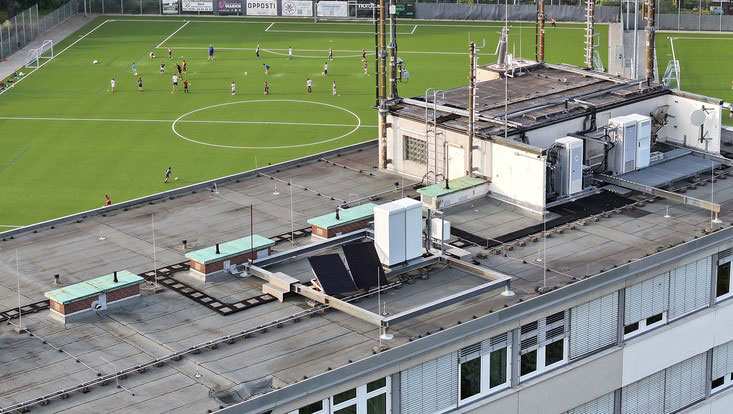by Janick Edinger (University of Hamburg)
The Follow-The-Sun-Computing project aims to leverage surplus solar energy generated by households for distributed computing tasks, aligning sustainable energy with digital transformation. By shifting computationally intensive tasks to locations with excess solar power, the project creates a decentralised system that bypasses energy distribution challenges and reduces CO2 emissions. This approach establishes a new market for computing power, utilising existing household infrastructure to achieve significant energy savings and environmental benefits.
Our current era witnesses two significant developments within the realm of the Twin Transformation – intertwining sustainability and digital transformation. These advances include: the groundbreaking accessibility of artificial intelligence (AI) models to the general public, and the ease with which individuals can generate solar power for household use. Although these developments appear independent at first glance, this project aims to identify and quantify the potential of a combined approach. The opportunities presented by intelligent digital assistants – especially voice agents – seem boundless. However, the high energy costs associated with new technologies pose a challenge. Currently, digital devices consume approximately 12% of global energy. Data centres in Germany alone consumed around 16 billion kWh in 2020, and this consumption is expected to rise. Efforts are underway to power data centres with green energy from renewable sources, but these efforts are hindered by limited energy distribution capacity.
On sunny days, substantial amounts of energy can be generated by photovoltaic (PV) or wind power plants, but often there are not enough means to transport this energy to consumers. In particular, large amounts of electricity from renewable energy sources in Germany cannot be transmitted to the energy-hungry industrial consumers in the south. Consequently, major energy producers are often disconnected from the grid and receive costly compensation in guaranteed feed-in tariffs. In 2022, over 800 million euros were paid in three German states alone for such compensations, while electricity needed elsewhere had to be purchased, potentially at high costs from conventional energy sources.
Private households face a similar challenge; advances in PV technology allow them to generate large amounts of electricity efficiently. Using this electricity within the household is not only the most efficient use of power but also offers cost advantages. However, when devices like electric cars and home batteries are fully charged, solar power systems may need to be shut down or the excess electricity sold to the grid. Legal hurdles and insufficient grid infrastructure exacerbate this issue. Solar and wind energy are highly regional phenomena, leading to simultaneous high energy production in neighbouring areas. This is where the Follow-The-Sun Computing project comes in. While transferring large amounts of electricity over long distances is technically complex and centrally controlled, data can be exchanged flexibly and locally with minimal latency. Computational tasks can be shifted to locations with surplus power. The necessary infrastructure, such as internet connectivity and capable computing devices, is already widely available in most households.
By consuming power where it is produced, this project eliminates the need for complex energy redistribution and bypasses administrative processes related to feed-in tariffs. Instead, a new market emerges where computational power is compensated through virtual or real currencies. Reciprocal models, not tied to actual currencies, are also conceivable. The granular nature of AI-agent requests, with computation times in the seconds-to-minutes range, allows for the real-time utilisation of unused computational capacities. Idle home computers, gaming consoles, and similar powerful devices can market their computing power – independently of grid feed-in regulations. This project seeks to identify and quantify the potential for using locally generated decentralised energy by distributing computational load. A system architecture based on the applicant’s prior work will be developed, enabling load distribution based on current energy production. A pilot study will be conducted involving the installation and operation of PV systems and connected consumers. Consumers will be divided into end-user devices, subject to actual usage and varying demand, and dedicated devices exclusively for third-party computation tasks. The findings will form the foundation of a model demonstrating the approach’s efficacy and potential for energy and CO2 savings. Finally, various factors and parameters will be identified to optimise the approach for larger-scale implementation.

Figure 1: In FTSC, the aim is to evaluate the possibilities of sharing computing operations in a server farm cluster among a group of autonomous solar power plants. The initial solar panels for the FSTC project have been successfully commissioned.
The project is structured into three major work packages. First, we assess the current state to estimate the potential of decentralised units for computationally intensive, request-based services. We capture and quantify the resource demands of traditional centralised computing, measuring attributes like system response time to ensure user experience remains consistent. Suitable measuring instruments are used to isolate and analyse resource usage, focusing primarily on energy consumption. A synthetic reference workload is generated to serve as a benchmark. Next, we design solar-powered, decentralised computing nodes, conceived as end-user devices in households. This involves configuring both hardware, consisting of PV modules and matched computing units, and software, including a lightweight operating system and middleware to enable workload distribution. Nodes use locally generated PV energy supplemented by grid connection for reliability. The middleware ensures tasks are routed to nodes with surplus solar power, tracked by intelligent meters, while a central scheduler optimises task delegation. Finally, we conduct a comprehensive evaluation and potential analysis of the decentralised solution, using the reference workload to redistribute tasks to solar-powered nodes when adequate energy is available. Nodes are installed in various German locations to capture regional effects and diverse measurements. The potential is assessed based on reduced energy demand in the central cluster minus the energy required for decentralised nodes during insufficient solar power. With this approach, we aim to establish a new market for computing power, utilising existing household infrastructure to achieve significant energy savings and environmental benefits.
Link:
https://www.inf.uni-hamburg.de/en/inst/ab/dos/newslist/2023-10-05-follow-the-sun-first-big-step.html
Please contact:
Janick Edinger, Universität Hamburg, Germany











